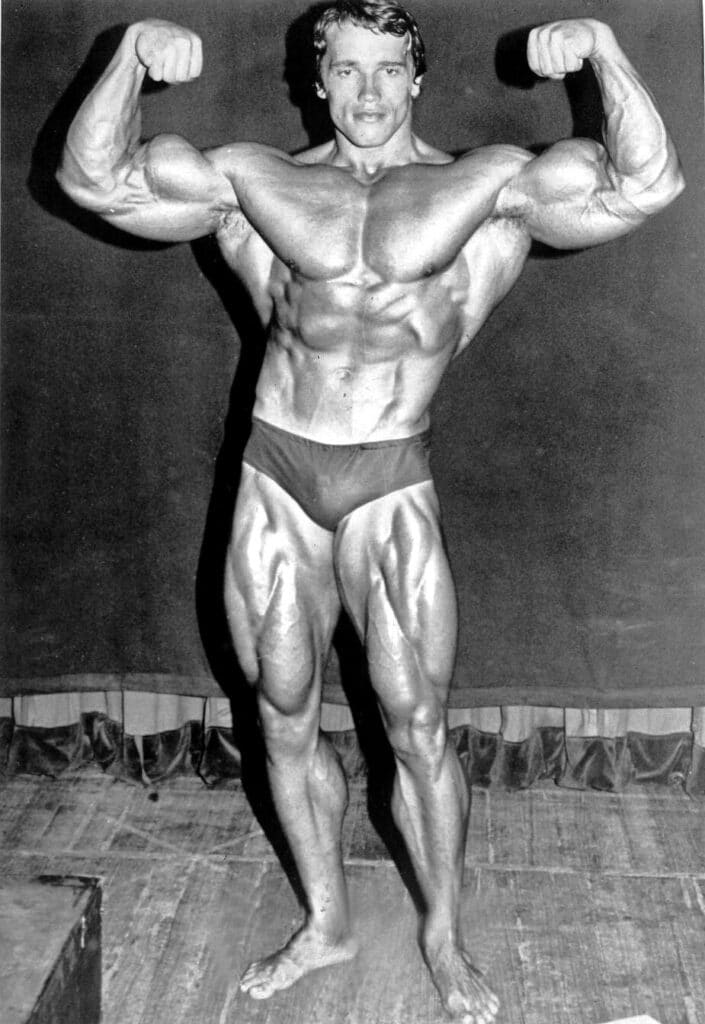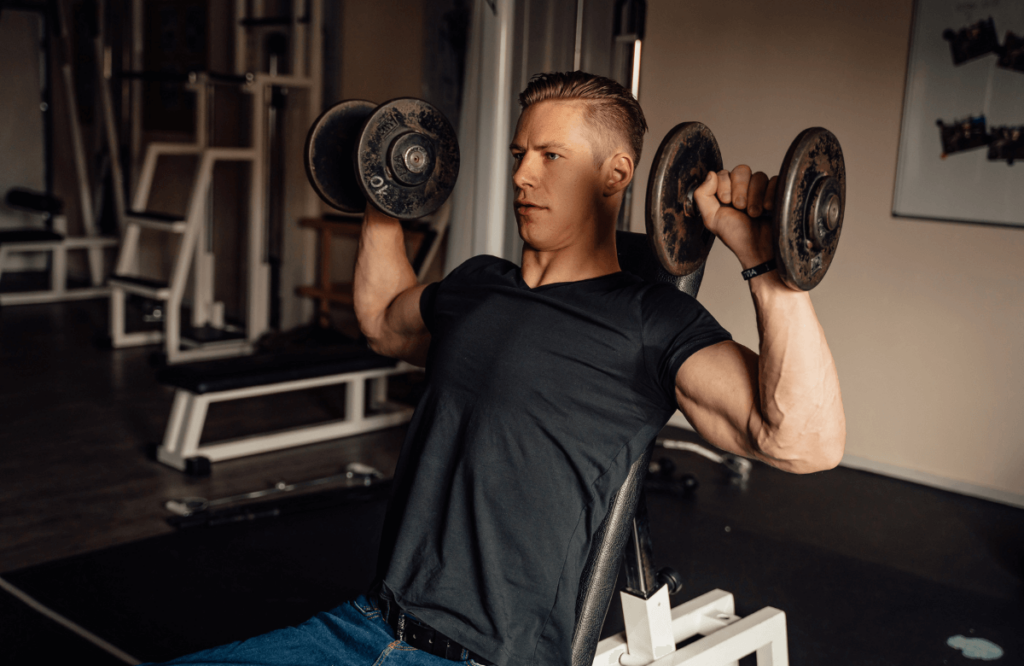Show off more toned shoulders by regularly incorporating the Arnold press into your workout. This lateral raise exercise is perfect for rounding out arm day and improving your strength and endurance. It could easily become a favorite exercise.
In this article, we’ll delve into what an Arnold Press is, the muscles it targets, and how to perform it correctly. Plus, we’ll explore the benefits and variations and how to seamlessly integrate the move into your shoulder workouts.
Jump to:
What Is an Arnold Press?
The Arnold press is a popular shoulder exercise that has become a staple in the fitness world, owing its name to the legendary bodybuilder Arnold Schwarzenegger.
This unique shoulder press variation incorporates a rotational movement that engages not just the shoulder muscles, but also works the entire shoulder joint.
With the right technique, incorporating the Arnold press into your routine can lead to boulder shoulders and increased shoulder strength. Whether you’re looking to build shoulder mass or simply wish to improve your range of motion and avoid shoulder pain, this exercise is worth considering.

What Muscles Should the Arnold Press Work?
The Arnold press is designed to work various muscles within the shoulder region. The primary muscle targeted is the deltoid muscle, which consists of three heads–the anterior (front), lateral (side), and posterior (rear) deltoids. The Arnold press efficiently engages the entire deltoid muscle, making it a comprehensive shoulder exercise.

In addition to the deltoids, the exercise also activates the muscles around the shoulder blades, such as the trapezius and the rotator cuff. These muscles contribute to the stabilization of the shoulder joint during the press.
Furthermore, the biceps get involved as secondary muscles, aiding in the rotational movement of the dumbbells. This makes the Arnold press an excellent exercise for those looking to develop broad shoulders and enhance upper body strength.
How to Correctly Do the Arnold Press
Performing the Arnold press correctly is essential for targeting the right muscles and avoiding shoulder injuries. Here’s a step-by-step guide:
Step 1–Starting Position: Sit on a flat bench with your back straight. Hold dumbbells in both hands at shoulder level with palms facing your body and your elbows bent.
Step 2–Engage Core: Before you start the press, engage your core stabilizer muscles to protect your spine and provide balance.
Step 3–Rotate and Press: Begin by rotating your palms so they face forward. Simultaneously, press the dumbbells overhead until your arms are fully extended.
Step 4–Elbow Position: As you press, make sure your elbows don’t flare out to the sides. Keep them slightly in front of your body.
Step 5–Lower Dumbbells: Reverse the movement by bringing the dumbbells back to the starting position, rotating your palms towards your body as you do so.
Step 6–Repeat: Perform the desired number of repetitions using lighter weights initially and gradually progressing to heavier weights as you build strength.
Remember to maintain controlled movements throughout the exercise, and avoid using momentum to lift the weights. This will ensure maximum engagement of the shoulder muscles and minimize the risk of injury.

6 Benefits of Doing the Arnold Press Regularly
The Arnold press is not just a fantastic exercise for sculpting broad shoulders, but it also brings many other benefits to the table. Whether you’re a beginner or an experienced lifter, incorporating this versatile exercise into your routine can have positive effects on your overall fitness.
Here are six key benefits of doing the Arnold press regularly:
1. Increase Shoulder Strength
The Arnold press is an excellent exercise to build shoulder strength. By working the entire deltoid muscle and surrounding stabilizers, it helps in developing strong and functional shoulders, which are essential for various daily activities and athletic movements.
2. Upper Back Muscle Development
Besides the shoulders, the Arnold press also engages the upper back muscles, especially the trapezius. This helps in building a balanced physique and adds to the upper body’s overall strength and muscle mass.
3. Target Several Muscles at Once
The Arnold press is a compound exercise that targets multiple muscle groups simultaneously, including the anterior, lateral, and posterior deltoids, biceps, and trapezius. This makes it time-efficient and highly effective in building upper body muscle.
4. Extend Shoulder Range of Motion
The rotational movement involved in the Arnold press helps in improving the shoulder joint’s range of motion. This can be beneficial in enhancing athletic performance and reducing the risk of shoulder pain and injuries.
5. Improve Posture
Regularly performing the Arnold press can help in correcting and improving posture. Strong shoulders and upper back muscles are essential for maintaining an upright posture, which is beneficial for overall spine health.
6. Lay the Groundwork for Major Lifts
The Arnold press lays the foundation for major lifts such as the bench press and standard shoulder press by strengthening the shoulder muscles and stabilizers. This makes it an invaluable exercise for those looking to progress in their lifting capabilities.
Incorporating the Arnold press into your shoulder workouts can offer a host of benefits. However, it’s important to use proper form and gradually increase the intensity to maximize results and avoid injuries.

Variations to the Arnold Press
As with many exercises, you can modify the Arnold press in various ways to add diversity to your workout and challenge your muscles differently. These variations can help in targeting different parts of the shoulder muscles and provide a refreshing change to your standard shoulder routine.
Here are three popular variations of the Arnold press.
Single Arm Arnold Press
The single-arm Arnold press is performed similarly to the standard version, but with one arm and a single dumbbell at a time. This variation helps in improving unilateral strength and addressing any muscle imbalances between the two shoulders. It also engages your core more as you need to stabilize your body while lifting one arm.
Incline Arnold Press
For this variation, you’ll need an incline bench. Sit on the bench with your back against the pad and perform the Arnold press as you normally would. The inclined position shifts the focus towards the upper chest and front deltoids, providing a different stimulus compared to the flat bench.
Cable Machine Arnold Press
Instead of dumbbells, this variation uses a cable machine. Stand in between the pulleys with the handles at shoulder height. Perform the Arnold press, keeping the movement controlled.
This variation offers constant tension on the muscles through the entire range of motion and can be effective in targeting the rear and lateral delts. It’s great for those with shoulder issues who might need more control in the movement.
You can integrate these variations of the Arnold press into your shoulder workouts for added diversity and challenge. By experimenting with different variations, you not only prevent boredom in your training regime but also encourage continuous muscle growth and development.
Remember to use proper form and start with lighter weights to ensure safety and effectiveness.
Common Arnold Press Mistakes
When performing the Arnold press, it’s crucial to avoid common mistakes that can hinder progress or lead to injury. Being mindful of your form and technique can greatly improve the effectiveness of this exercise.
Let’s take a look at a few common mistakes and how to avoid them.
Improper Weight (Too Heavy or Too Light)
Using weights that are too heavy can lead to improper form and increase the risk of shoulder injuries. Conversely, using weights that are too light may not sufficiently challenge the muscles. It’s important to choose weights that allow you to perform the exercise with the proper form for the desired number of repetitions.
Forgetting Your Core Stabilizer Muscles
Neglecting to engage your core stabilizer muscles can cause an unstable base and unnecessary strain on the lower back. Before initiating the press, tighten your core to provide stability and protect your spine.
Failing to Fully Rotate
One of the unique aspects of the Arnold press is the rotation of the palms. Failing to rotate the palms throughout the range of motion reduces the exercise’s effectiveness. Ensure that you rotate your palms from facing your shoulders to facing forward as you press upward.
Relying on Momentum
Using momentum to lift the weights takes tension away from the shoulder muscles and can lead to injury. It is important to control the lifting and lowering phases of the exercise, focusing on muscle engagement rather than momentum.
Avoiding these common mistakes when performing the Arnold press will help you maximize the benefits of the exercise while reducing the risk of injury. Take the time to focus on proper form and technique, and make necessary adjustments to continually progress in your shoulder workouts.

How to Add Arnold Presses to Your Exercise Routine
Adding Arnold presses to your exercise routine is a wise decision for enhancing shoulder strength and mobility. Begin by including them in your shoulder or upper-body workout days. Since it’s a compound exercise, it’s advisable to perform it near the start of your workout when your energy levels are high.
Start with lighter weights to familiarize yourself with the movement, and gradually increase the weight as you become comfortable. Aim for 3-4 sets of 8-12 repetitions, and make sure you allow ample rest time between sets.
As you advance, you can experiment with the variations mentioned earlier to keep the workout challenging. Always pay attention to form, and don’t hesitate to ask a fitness professional for guidance if you’re unsure about the technique. Incorporating Arnold presses in a balanced and progressive manner will reap significant benefits for your shoulders and overall upper body strength.

FAQs
Still have questions? Let’s see if we can answer a few.
Is an Arnold Press the Same as a Shoulder Press?
No, the Arnold press and shoulder press are not the same. While both exercises primarily target the deltoid muscles, the Arnold press involves a rotational movement of the palms which is not present in the regular shoulder press.
In the Arnold press, you start with your palms facing toward you and rotate them to face forward as you press the weights overhead. The standard shoulder press involves a simple vertical pressing movement without rotation, and palms usually face forward throughout the exercise.
Is a Shoulder Press or Arnold Press Harder?
The Arnold press is generally considered to be more challenging than the standard shoulder press. This is because the Arnold press engages more muscles due to the rotational component, and requires a greater range of motion.
The additional rotation demands more control and stability, making the exercise more complex and challenging compared to the straightforward pressing movement of the shoulder press.
Is It Better to Sit or Stand for an Arnold Press?
Both sitting and standing positions have their own benefits when performing the Arnold press. The seated position provides more stability and allows you to focus solely on the shoulder muscles. It’s often recommended for beginners or those lifting heavier weights.
On the other hand, performing the Arnold press standing engages the core muscles more effectively and simulates a more functional and athletic movement. Advanced lifters often opt for the standing position to incorporate more muscles and add an element of balance and coordination to the exercise.
Choose the option that aligns with your fitness goals and level of experience.














